Monday Afternoon April 11, 2016 Most Recent Posts:
Animal Kingdom Finishing Our Morning in Asia
Walt Disney World The Joy of Animal Kingdom is in the Details and the TIGERS
Orlando, Florida
In my last posts (links above) we had just spent the morning in Asia having a wonderful time seeing exotic birds, tigers, and giant bats as well as the marvelous details created by the Disney Imagineers.
It’s lunch time now. We make our way to the African town of Harambe where we hope we won’t need accomodations in the guest house by losing track of time and staying too late.
Before exploring the colorful village whose name in Swahili means “come together” we decide to forego the lunch we have brought with us and have some authentic food.
We look over the menu at the Harambe Market and make our choices. David grabs a table, I get the food.
As you can see both above and below, David has chosen the Beef and Pork Sausage fried in curried corn batter and served with green papaya slaw and black eyed pea, corn and tomato salad.
I chose the all beef flatbread with the same sides. They were all unique and delicious.
Thus fortified, I think we are ready to leave the town for the back country but David has other ideas.
It’s these sorts of details all around town that make us feel like we have come to a small place in South Africa.
I wonder if he could handle Multiple Myeloma?
We head out the gates of the city and on to
For those who enjoyed the birds in my last post about the Maharajah Jungle Trek will love our visit to the aviary on the African Pangani Forest Exploration Trail. As previously, the birds are identified on their photographs.
As with many birds these are often around the water features. I love the bucket just hanging off the faucet. What a great idea for a bird bath or waterer. Clearly this handsome magpie shrike thinks so.
I didn’t take pictures of as many different birds here in Africa. I got very caught up with the little Taveta Golden Weavers.
I just laughed and laughed as he jumped in the water and splashed it all over himself repeatedly.
Their name comes from the little nests they weave all over the tiniest branches of the trees.
The waterfall and pool were home to several geese and ducks including the pgymy goose and the black crake with orange feet and a green bill.
Look who is also having lunch, the Nile Hippopotamus. He’s HUGE! We learn that they walk along the bottoms of riverbeds and spend much of their day sleeping or resting in the water. They graze on land at night in a normal life but I guess life here is not quite normal.
Nile hippopotamuses (Latin is hippopotomi) grow up to 15 feet long and weigh up to 8,000 pounds. That’s the size of a mid-sized car. They stand from four and a half to five and a half feet tall. They live only in sub-Saharan Africa in rivers, lakes, and wetlands from western African countries like Guinea east to Ethiopia and south to northeastern South Africa. They live up to 45 years in the wild.
Aren’t they great!
They consume up to 88 pounds of grass per day which is about half that required by other hoofed mammals. Hippos' habit of resting in water during the day reduces energy and food demands.
Like the alligator, their eyes, ears and noses are all on top of their heads so that’s what you can see when they submerge themselves in water. Wow imagine that coming toward you as you are paddling down a river.
Last time we were here, we saw them in the water. You can see those pictures here.
Further along we come to the Zebras with a Meercat audience.
We learn that Disney World actually has quite a few Zebra groups. They are herd animals, members of the equine family like horses. There are 4 species of zebra here. Grevy’s zebra and Grant’s zebra are here on the Pangani Forest Trail and the Hartmann’s mountain zebra and the Somali wild ass are at Disney’s Animal Kingdom Lodge. I think we may have to tour the Lodge on our next trip to Disney World and check this out.
Grevy’s zebra are the most endangered equine in the wild and originate from Kenya and Ethiopia. They face declining populations due to the loss of accessible water sources and diminishing suitable habitat
Last time we were here at the Meerkat burrow, one was standing guard in just this spot, looking all around for predators while the others seemed to be playing and having a great time. Today the group is all together watching the zebras for the entire time we are watching them. Meerkats are actually part of the mongoose family, and their natural habitat is the
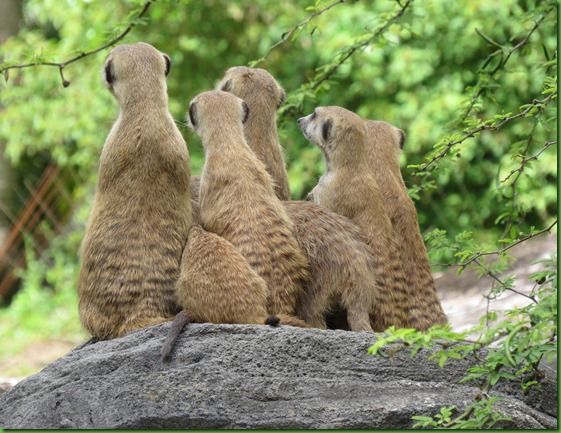 Kalahari Desert, Botswana, and South Africa. They live together in highly organised groups, called mobs, gangs or clans, and these groupings often contain between 20 to 30 meerkats. They live, on average, between 12 and 14 years, and their habitat is a large underground network of tunnels, with multiple entrances.
Kalahari Desert, Botswana, and South Africa. They live together in highly organised groups, called mobs, gangs or clans, and these groupings often contain between 20 to 30 meerkats. They live, on average, between 12 and 14 years, and their habitat is a large underground network of tunnels, with multiple entrances.
Meerkats are diurnal, resting at night and becoming active by day. Their bodies are long and sleek and measure between 10 and 14 inches, but their long thin tail adds another 7-10 inches. When standing up, they use their tails for balance.
They have small black crescent shaped ears that can close when they dig so that sand doesn’t get in them,isn’t that cool, and long, strong, curved claws which help them dig their underground burrows. They eat mainly insects but also may eat snakes or lizards, eggs, small mammals, scorpions and spiders. Scorpions really? Apparently they are not immune to the venom, which can kill a human, they simply bite the stingers off and then eat the scorpion.
Meerkats really are great fun to watch even when this is what they are looking at. How about those designs.
And finally we come to the gorillas which at some point nearly always bring me to tears. They are so like us, they share 98% of our DNA. They are so amazing and so endangered. They are large and powerful, gentle and playful, even shy. They seem just like us.
Gorillas can be found in 8 different countries across central and western Africa, typically in lowland tropical rainforests with dense ground-level herbaceous growth.
There are 2 gorilla species, western gorilla and eastern gorilla, each with 2 subspecies—one that lives in the lowlands, one that lives at higher elevations.
The gorillas here are western gorillas and Animal Kingdom has two groups, the family and the bachelors. Gorillas live in family groups of 2 to 30 members with one silverback leader and several unrelated females and their young. Blackback males stay in the group until maturity, then leave to form their own groups.
The western lowland gorilla is listed as critically endangered. Since the early 1980s, disease, habitat loss and illegal hunting of gorillas have decimated populations in many otherwise intact forests.
Their loss of habitat is due primarily to commercial logging, agricultural expansion and the increased mining of coltan and other metals that are needed to produce modern electronics. More on this later.
Another huge threat to the gorillas comes from poaching of gorillas for their meat. “Bushmeat” is considered a delicacy among some urban populations. Demand for it continues to rise. Since the early 1990s, infectious diseases like Ebola have also been crippling gorilla populations.
Western lowland gorillas are skilled foragers who enjoy a low-fat, high-fiber, high-protein herbivore diet. Sounds like what we eat. But occasionally they take a break from their vegan diet to indulge in a tasty treat of ants or termites. Umm no thanks.

Their size can be intimidating, but the information about them describes them as being by nature quiet, gentle and peaceful unless provoked.
Like us they have individual personalities, are charismatic, intelligent and highly social.
Since 1997, 5 western lowland gorillas have been born at Disney’s Animal Kingdom park—2 of them in 2014! I’m assuming they must be pretty happy here to mate and have their young.
Gorillas are born small (4 to 5 pounds) and cling to the mother’s front for the first 6 months. They then travel on mom’s back—when not nursing or traveling short distances—and are weaned around 3 years old.
Gorillas are one of the few animals that laugh out loud when playing. They use body language, gestures and facial expressions to communicate, and up to two dozen different sounds and vocalizations, from grunts to whines
Gorillas are quadrupeds, typically walking on all fours with their fingers curled under, called knuckle-walking. Like all apes, their arms are longer than their legs, which helps support the weight of their head and chest. Unlike monkeys, they have no tails.
We spend a while watching the family members interact before moving on to the bachelor area where we find afternoon nap time is happening for at least one.
Well, maybe not a nap, maybe just a rest. I just love this face, those eyes.
Also like us Gorillas have 32 teeth, pregancies that last 8 1/2 months, 5 fingers on each hand with opposable thumbs.
Unlike humans, gorillas also have opposable big toes that can deftly pick up and manipulate objects, and noses that are so unique, no two are alike, that researchers use nose shapes to identify gorillas in the wild.
I think these opposable big toes would come in mighty handy. Wonder if you could learn to paint or write with them? Ever dropped something on the floor and wished you could pick it up with your toes?
I find the gorillas fascinating and SO wish they could be wild and free in the jungle to carry on their family lives without any interference from us.
But becasue of the interference of some, others must take up the cause of their protection.
I was really happy to learn about the DCF. Since it began in 1995, the Disney Conservation Fund (DCF) has contributed more than $40 million dollars to support conservation programs in 115 countries around the world—including over $4 million to support projects that protect primates.
In the Democratic Republic of Congo, funding from DCF helped the Dian Fossey Gorilla Fund open the Gorilla Rehabilitation and Conservation Education (GRACE) Center, which rescues gorillas that have been orphaned by poaching and animal trafficking. Young gorillas that would have died on their own are brought to GRACE to live in a family with other gorilla orphans, where they learn the social and survival skills they will need for later reintroduction back into the wild. Disney helped design and build the GRACE Center, and continues to send Disney animal care staff and veterinary and education specialists to work with the gorillas and offer training to GRACE’s animal care and education staff.
That’s what Disney is doing. I also learn what we can do. Take a look at these 4 simple things we all can do to help.
First, in order to decrease the need for mining of coltan and other metals needed to produce modern electronics, recycle your old cell phones, laptops, MP3 players, tablets, video game systems and all electronic waste. Don’t just let it sit around in a drawer or your garage. Give it to someone who will retreive the metals.
Secondly, in order to decrease the decimation of their forests, purchase wood and paper products certified by the Forest Stewardship Council Look for FSC logo.
Thirdly, to support the economy of these areas for something other than logging, buy forest friendly products like shade-grown coffee and items made from sustainable bamboo. I don’t drink coffee but David does so heads up coffee drinkers. Spend a little more and help the gorillas. Our cutting board is from sustainable bamboo and it was not more expensive. Many many exotic woods come from the African forests.
And finally, buy “Save Vanishing Species” post office stamps, which help endangered species like gorillas, tigers, elephants and rhinos. I didn’t even know about these and will for sure go to my post office and request them rather than my current “forever” stamps. They cost a little more but I don’t send much mail anyway so it’s the least I can do. The link will take you to the information about these stamps but you’ll have to click on the Read More> link
I can spend hours just watching the gorillas and how they relate to each other, and listening to the stories those who work with them have to share. If you haven’t yet wandered down the pathway into the Pangani Forest, don’t miss it on your next Disney trip.
From here we’re off on a Safari.
![IMG_4951_thumb[1] IMG_4951_thumb[1]](https://blogger.googleusercontent.com/img/b/R29vZ2xl/AVvXsEjZCOQ7zyxMSZIBlcRunca_oRhwF6EP2wavn88oqaSDmZgHjC7enbvdgnE725a_Ce6QlqcVBy0FonAkTFicl3fudsKD8Fs3Vq4F8_ypIN0goPIhyDQpNIlKfAgT0k4bi2jvmnnCcFifGzU/?imgmax=800)
![IMG_4952_thumb[1] IMG_4952_thumb[1]](https://blogger.googleusercontent.com/img/b/R29vZ2xl/AVvXsEgInJ4qJxUfF0no07F-FVU1EHdx232ojcvcSCtakVi1aiEqw21Cs-a0vIZgrhfLHRu9dvMsDWjMcRn6haXY0E0SDkAgiMKJLoFbopZjv0t9W_wST9WymjLzusAIEXbaY-7JO_jiNetN3XKk/?imgmax=800)
![IMG_4953_thumb[1] IMG_4953_thumb[1]](https://blogger.googleusercontent.com/img/b/R29vZ2xl/AVvXsEgauHezfvtdQuVWlk3oTAbgqTcVy4yua7U4Fa3ZGakhIr9Y7MTQre4u30TJxe5ErgpfvdKpZGsTDoTrBffWs7TbzqvLdNcdVFjUC2N4VuxuRqNQsdcOQ1LnVqIBbiXX2rh9xpyjtwAvQ9sL/?imgmax=800)



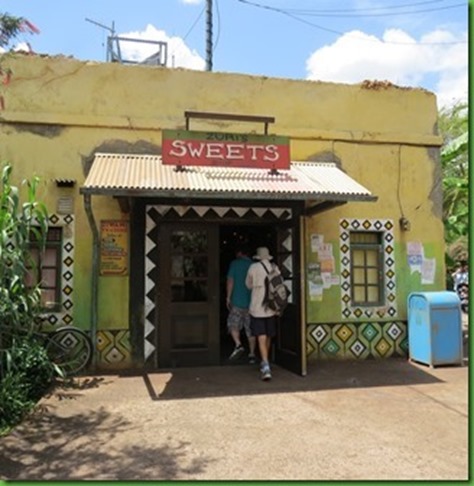


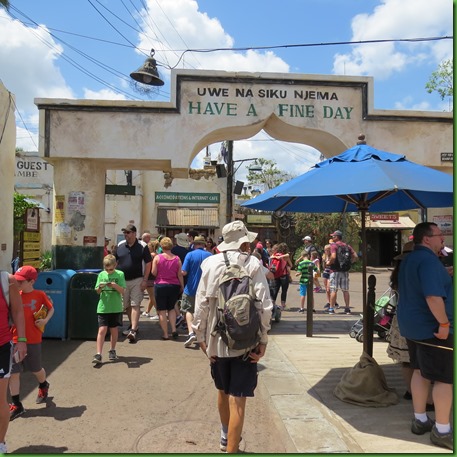















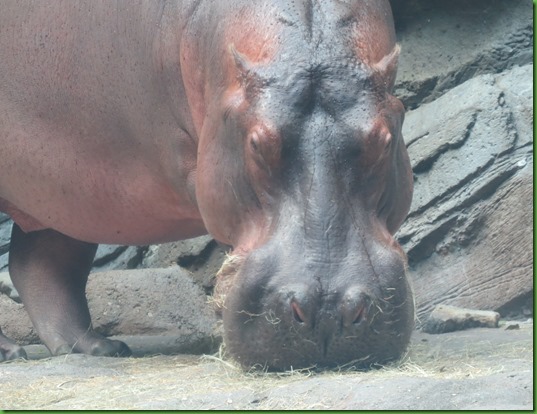
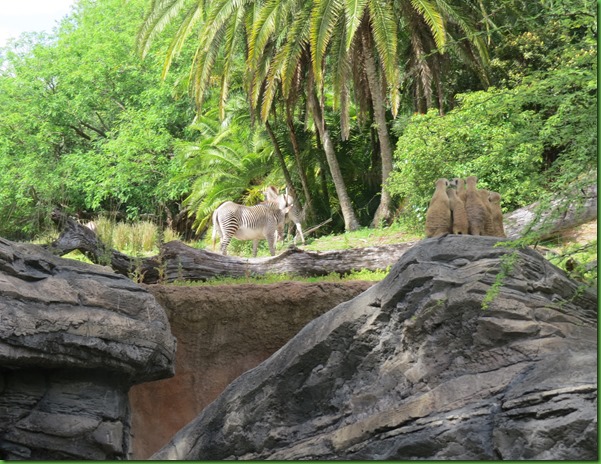











"Western lowland gorillas are skilled foragers who enjoy a low-fat, high-fiber, high-protein herbivore diet. Sounds like what we eat." That statement made me laugh after you wrote about David's beef and pork sausage fried in curried corn batter and your beef flatbread ;-)
ReplyDeleteI just love those photos of the gorilla hands and feet. Thanks for the info about what we can do to help protect them.
Good point. I should have said, "when we are at home or pack lunch". When we eat out, like today, anything goes.
DeleteYou mean others cannot pick up things with the toes? I can, and thought everyone could do it. Not big things, of course, but small things like pencils and other such items are easily done.
ReplyDeleteVirtual hugs,
Judie
You guessed it, I love the birds. :-) And the meerkats are so cute all huddled together! It sounds as though Disney is doing wonderful work for the gorillas. Thanks for the suggestions for what we can do -- we've been drinking shade grown coffee for years, buying sustainable wood and paper products, and recycling electronics -- but I didn't know about the stamps.
ReplyDeleteJust reading the blog has inspired us to plan a trip to Disney sometime soon. There is so much that we haven't seen there. We are fortunate to be able to see these wonderful animals even if they are in captivity. Thanks for the tips on conserving.
ReplyDeleteIt sounds like Disney's doing some good. The gorillas are remarkable to see.
ReplyDeleteAll of these creatures you describe here are so wonderful! You can easily lose yourself and forget you are in a "theme park" - especially when reading your blog. Thanks for all the information, and yes, I will be sure my coffee beans say "shade-grown". All so beautiful and amazing, but no doubt the meerkats are the cutest!
ReplyDeleteI say pretty cheap for a trip to Africa. lol So glad to see you enjoying the food and fun and thriving. You will never be sorry for the investment you made and memories for a life time. Wonderful! Thanks for taking us to Africa with you! :-)
ReplyDeleteI think many of us could use a good Herbalist! Oh, the tail on that magpie!
ReplyDeleteMy post office only has the tiger from the "Save Vanishing species" collection. I use it on most of my mail, and the Harry Potter stamps for kid's birthday cards, etc.
Years ago I watched a bored silverback at the Cincinnati zoo, and that was what turned me off zoos forever, including any kind of animal collections.
Thank you for such a positive upbeat post about the good things Disney does to help animals. Many people go there and it is an education for them also, changes viewpoints about the planet we all share.
ReplyDeleteA most excellent post.
You sure are doing a wonderful job describing this all for us. I'm for sure going there next winter. You should be a guide. And David's sweet tooth cracks me up.
ReplyDeleteMy favorite post so far! Love to watch birds bathing themselves, they're so cute. Meerkats are just the best looking of the burrowing creatures. Love the zebra butt :) Gorillas are so like us, the look in their eyes seem to show so much love. Great pictures! I don't mail much through the post office, but will be on the lookout for those types of postage.
ReplyDeleteWhat a wonderful day you two had!!! Your photos are spectacular and your commentary thought provoking. Learned a lot from this post!!!
ReplyDeleteYour bathing weaver is an amazing photo! Their little nests are works of art. I can see why you would spend some time with them :-) The meercats are a riot, I half expect them to hold up score cards for the designs of each zebra! I'm a big fan of African food, the flavors are so intense, although it is very difficult to find outside major cities. I can see why these posts are taking you awhile to get through. Not just the wonderful detail (thank you for all that work), but when the connection to these beautiful creatures is so strong how can you possible convey in words the contradiction of confinement and conservation? I think you've done a wonderful job with your tigers and gorillas. I haven't needed stamps in months, but we do buy the coffee and bamboo whenever available, and recycle electronics as well. If everybody did it all.......
ReplyDeleteOMG, other than the gorillas I felt right back in South Africa. Watching the Weavers build those nests is an architectural wonder. Haven't seen All those types of zebras yet either. Once again Disney comes through.
ReplyDeleteTwo thumbs up for Disney's contribution to conservation. It helps take some of the sting out of their ticket prices. ;c)
ReplyDeleteNice pictures in your post, I love your eye for details that so many people miss (including me!).
I learned a lot from this post. Gorillas are definitely amazingly like us. Glad to hear Disney is helping. I like the other animals too. Those rhinos look impressively large!
ReplyDelete